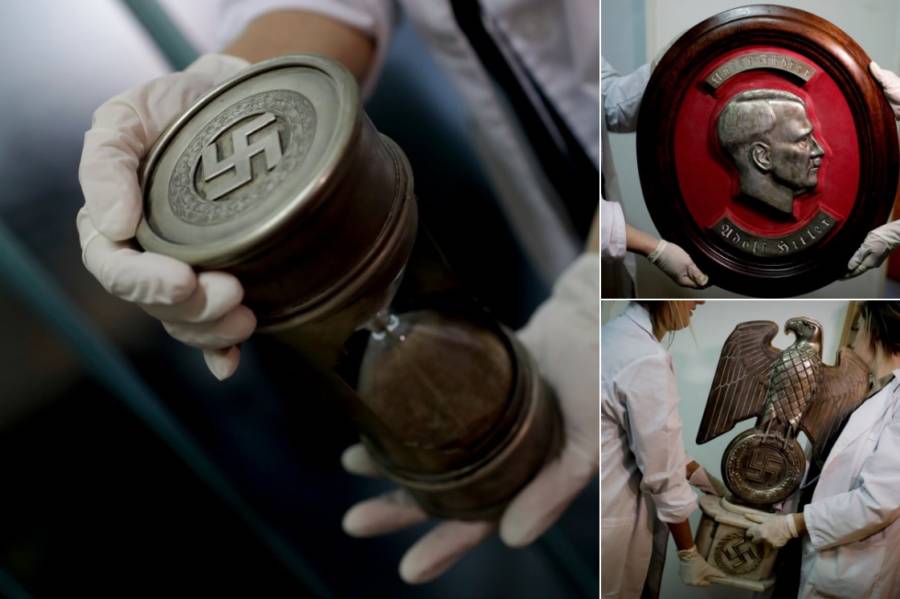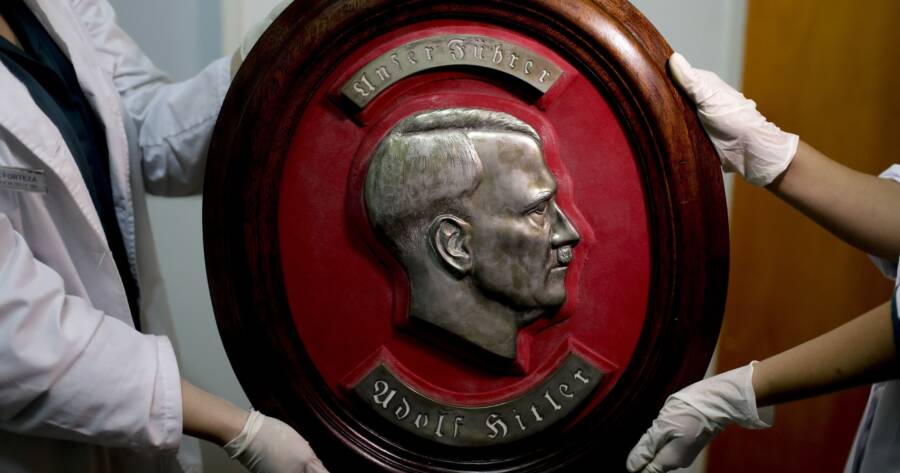In 2017, historians thought that they'd hit the jackpot with this collection of Nazi artifacts. Two years later, they were revealed to be fakes.

Twitter/APSome of the items uncovered in the 2017 raid of Argentina’s largest-ever stash of Nazi artifacts. Two years later, they were revealed to be fakes.
In 2017, what was thought to be the largest collection of Nazi artifacts in Argentina’s history was discovered in a suburb of Buenos Aires. More than 75 artifacts — including some that were thought to have been used by Hitler himself — were found in a hidden room inside a collector’s home.
The trove included magnifying glasses engraved with swastikas, a bust of Hitler, a box of harmonicas, and a scary-looking caliper used to measure heads in a discredited medical technique known as phrenology, which was used by Nazis to distinguish “Aryans” from Jews.
But just two years later, most of the bounty was revealed to be nothing more than a fraudulent collection. So how were the perpetrators able to pull off the scam? And how was the ruse revealed? The answers are just as shocking as the find itself.
When they were first discovered, authorities believed that many of the pieces belonged to high-ranking Nazi officials. This theory was supported by photographs found with the collection — one of which showed Hitler using a magnifying glass similar to the ones that were confiscated.

Twitter/APLinguistic errors and other mistakes in these objects revealed them to be forgeries.
“We have turned to historians and they’ve told us it is the original magnifying glass (that Hitler used),” Nestor Roncaglia, the head of Argentina’s federal police, said in 2017. “We are reaching out to international experts to deepen (the investigation).”
Investigators had been tracking this particular collector for some time because illicit artwork was found in a local gallery — and they raided the house on June 8, 2017. When they raided the house, they found a large, suspicious-looking bookshelf that turned out to be a hidden door.
Behind it, a secret passage led to a room filled with what was thought to be authentic Nazi paraphernalia. But it wasn’t.
Of the 75 or so Nazi artifacts discovered by authorities in Argentina, only 10 of the artifacts were revealed to be genuine.
The revelation came after Dr. Stephan Klingen of the Central Institute for Art History in Munich, Germany, traveled to Argentina in March 2018 to examine the finds. He also consulted with more than 30 other experts to understand what was truly going on.
But according to Klingen, there were far too many errors in the artifacts for them to be considered even remotely genuine. “The signage of the objects has multiple spelling errors, the National Socialist symbols were used in the wrong context.”

Twitter/AP Of the 75 artifacts in this supposed Nazi collection, only 10 appear to be genuine.
He added that the “Nazi artifacts” had so many linguistic errors that they were most likely made outside of German-speaking areas.
The few pieces that appear to be genuine Nazi items include three toolboxes from a Mauser munitions factory, a Nazi-era newsreel, and several busts of Adolf Hitler. “But because we were not allowed to do material investigations, even their authenticity could not be checked conclusively,” said Klingen.
While this isn’t the first time that alleged Nazi artifacts were revealed to be bogus, it’s the first time in the 21st century that such a forgery made such a huge splash.
But even after this gob-smacking revelation, Jonathan Krszenbaum, director of the Museo del Holocausto, felt it was essential to display the whole collection, including the falsified Nazi objects.
“They are original objects – original from the period – even if they were modified later. The skull-measuring instrument, even if the swastika was added later, is still from the Nazi period, or from the pre-Nazi period, and as such it has educational value because it exemplifies the Nazi obsession with the question of race.” He explained.
“They are not forgeries – they are originals that were adulterated later. That doesn’t reduce their historical significance.”
Now that you know that these Nazi artifacts are fakes, read about the true story of the Nazis who defended China from the Japanese. Then, learn about the true story of the American arm of the Nazi party before and during World War II.





